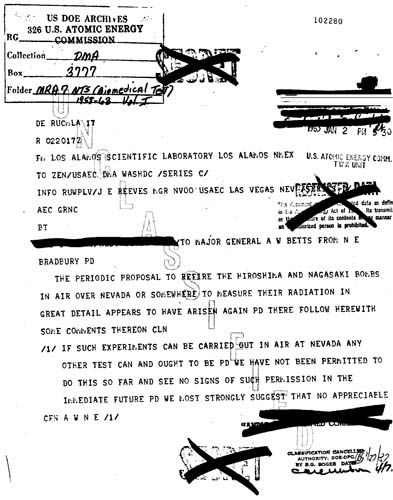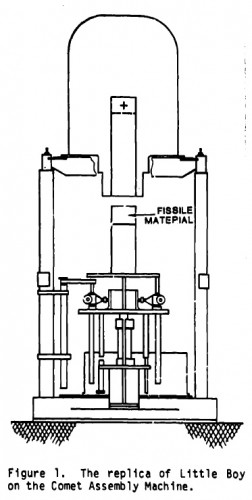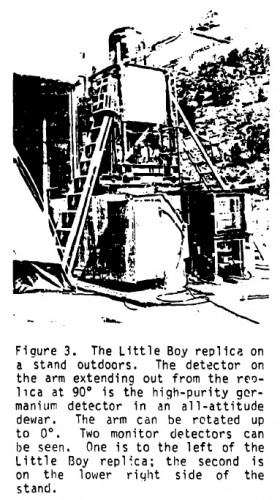As everybody knows, the bombings of Hiroshima and Nagasaki were the only instances of actual combat detonations of nuclear weapons. The victims of the bomb — the Hibakusha — were also the one-and-only direct human test subjects on the effects of the bomb. This grim connection between victims and experimental subjects runs through quite a bit of the scientific literature on nuclear health.
A doctor working for the Atomic Bomb Casualty Commission examines a Hibakusha in the postwar period.
After World War II, the US sent over physicians and specialists to find out as much as they could on the survivors of the atomic bombs. Japanese physicians were of course already doing this themselves. This work was eventually consolidated into the Atomic Bomb Casualty Commission.
Starting in the mid-1950s, when the US government became concerned about Civil Defense against atomic bombs, scrutiny of radiation data from Hiroshima and Nagasaki became a major preoccupation. What exactly was the radiation output of the Hiroshima and Nagasaki bombs? Nobody knew. They hadn’t really kept as good tabs on that as they perhaps ought to have. Oppenheimer, Groves, et al., hadn’t even really thought that much about the radiation effects before dropping the bombs. 1
The Nagasaki bomb, at least, was an implosion model, and these had been not only continued to be tested after the war (the Operation Crossroads weapons were essentially Fat Man devices), but were the subject of on-going interest and development. The Hiroshima bomb, Little Boy, was a model that was obsolete even as it was being dropped. (Literally: Oppenheimer proposed to Groves that they abandon it; by removing all of the HEU inside the single Little Boy bomb, they could make half a dozen HEU-fired Fat Man bombs.) Nothing terribly similar to the Little Boy bomb would ever be dropped again (only four gun-type devices were ever detonated, ever, and the later ones — one W9 and two W33 tests — were different enough that their radiation spectrum was probably not the same).
One way that you could carefully measure the radiation output of the Little Boy bomb would be to test another one — say, out in the Nevada desert. In 1963, Norris Bradbury, director of Los Alamos, wrote out exactly why he thought this would be a bad idea. ” The periodic proposal to refire the Hiroshima and Nagasaki bombs is air over Nevada or somewhere to measure their radiation in great detail appears to have arisen again,” Bradbury wrote, and then enumerated a number of reasons against it. 2
First on the list is the fact that by 1963, the United States had signed the Partial Test Ban Treaty, barring any kind of nuclear tests in the atmosphere. So the possibility of detonating an old Little Boy bomb in the atmosphere “has about the chance of a snowball in you know where,” wrote Bradbury. (Why not underground? Bradbury doesn’t say, but elsewhere I’ve seen it pointed out that the entire point of such an exercise would be to understand the radiation in the atmosphere. Doing it underground would involve a lot of fudging, apparently.)
Second on the list was the difficulty of putting together fair replicas of the 1945 bombs. While parts of the Nagasaki bombs could probably be rustled up, “new X-units would be required,” (the X-unit was the firing electronics), and “the different X-unit would certainly cause some difference in the radiation spectrum and distribution.” Put another way, they just didn’t have exact replicas of the Little Boy and Fat Man bombs by 1963. Bradbury offers up that the Mark-6 bomb would probably be pretty close to the Nagasaki bomb. “LASL is not repeat not going to make a replica of the Nagasaki bomb in this day and age for this type of purpose. It is worth neither the time nor the effort. If a MK 6 will not do — then forget it.”
Third on the list is related specifically to the Little Boy bomb: “We could probably make a reasonable replica of the Hiroshima device. Some old LBs probably exist in part. They are unsafe (remember Parsons‘ famous bomb bay insertion of the active material?) and some type of safing would have to be dreamed up.” Bradbury earlier describes these old weapons as being “hideously unsafe.” He concludes that the differences between a Little Boy replica and the actual one would not be as big as between the Mark 6 and the Fat Man, but the differences “will take time and effort to work out.”
Lastly, he laid out exactly how much of a bad idea he thinks it was:
Unless these experiments are likely to be real, we see no reason to give much more than idle speculative effort thereto and do not [sic] real work. Let us not kid ourselves — making these devices and shooting them is going to be real work and totally unproductive work from the standpoint of weapon development. In my personal opinion, although doubtless based more on emotion than on scientific reason, the experiments will add little of practical utility in the high level dose rate area anyway. What does one do with the information when (and if) one has it? Some people get exposed at some level and die; some do not; some get malignancies; some do not. That will remain true whether we know the MLD 50 to 5, 10 or 50 Roentgens. Basically, with test money cruelly short and with testing philosophy cruelly restrictive why should we waste effort on this sort of thing?
One wonders what the cause of the “emotions” were. Dredging up memories of old and difficult work? Just a feeling that he was wasting time? Frustration with the atmospheric test ban? A lack of interest in the Hibakusha?
They never did re-test Little Boy. What they did do, some many years later, was create a replica.
The “Little Boy Replication Project” involved putting together the “Comet Assembly Machine” 3, and was essentially a very small prompt-critical reactor. That is, it was an assembly that could be brought just up to criticality and then stopped before it went too far. The operation of the machine would raise a chunk of fissile material into another chunk, and they would then take all sorts of neutron measurements. On top they put the front-end of an extra Little Boy bomb casing that was left over from the war. 4
Why go to all the trouble, in the end? As a report on the replication project explains:
Nearly all evaluations of the long-term effects of exposure to radiation for a human population are derived from observations concerning the survivors of Hiroshima and Nagasaki. Although the medical history is well documented, the radiation exposures are still uncertain. Fat Man, the Nagasaki weapon, is well understood and has been subject to numerous comparisons between calculation and observation. Little Boy is not understood; it was unique, never tested, and, until recently, never duplicated. 5
Little Boy was also, the authors of that study claim, “a neutron leaker.” I don’t know what that means (Fat Man is a “gamma-ray source” by comparison), but it’s a funny term.
Another paper using the Little Boy Replica put it this way:
Most of our radiation safety guidelines in the nuclear industry are based on the data concerning the survivors of the nuclear explosions at Hiroshima and Nagasaki. Crucial to determining these guidelines is the radiation from the explosions. 6
Apparently the replica worked well, and they were able to use it for all sorts of different experiments well beyond what they originally intended. I find it such an unexpected story, personally. We base our radiation understanding on the victims of the bomb. But it turns out we used the bomb without knowing too much about it, and by the time we realize that, it’s far too late to make or set off another. So an elaborate machine has to be invented, one which simulates (in a non-explosive way), technology that by that point was well over thirty years old, so that we can recapture some of that old knowledge in order to calibrate our standards for the present. It’s a round-about connection between victims and experiments, bombs present and past, knowledge old and new.
- Sean Malloy has a fascinating article about this coming out in Diplomatic History next month; I am writing something up on it to share then as well.[↩]
- Citation: Norris Bradbury TWX to A.W. Betts (2 January 1963), copy in Nuclear Testing Archive, Las Vegas, NV, document NV0102280.[↩]
- The “Comet” machine was named for Jano Haley, its designer — it was, thus, Haley’s Comet. Har har. I first heard of this device through John Coster-Mullen’s work.[↩]
- For background on the project, see Richard E. Malenfant, “Little Boy Replication: Justification and Construction,” LA-UR-84-1726 (June 1984). If you search the DOE’s Information Bridge for “little boy replica,” you can get many papers about the various experiments done with it. Figure 1 is from the “Justification and Construction” document; figure 3 is from this document.[↩]
- Malenfant, “Little Boy Replication: Justification and Construction.”[↩]
- C.E. Moss, M.C. Lucas, E.W. Tisinger, M.E. Hamm, “Gamma-Ray Spectra and Doses from the Little Boy Replica,” LA-UR-84-1613 (June 1984).[↩]





Just a small correction: according to LA-UR-84-1726, the Comet was a delayed critical assembly, not a prompt critical one. They did not use it for short, energetic pulses: it was run on low power for longer irradiation times to measure the gamma and neutron field around the device.
I am wondering why they got the permission and resources to do this experiment in the 1980s. Perhaps some people wanted more precise information on the health effect of neutrons because of the neutron bombs stationed in Europe…
Ah, good catch. Yeah, I don’t know why then and not, say, in the 1960s, or the 1970s. LA-UR-84-1726 makes it clear that they had tried to get this sort of data through other means in the mid-1960s but found it unsatisfactory. But why it took until the 1980s to mount an authentic LB assembly on the top of a critical assembly, I don’t know.
The LA-UR-84-1726 comment describing the Little Boy bomb as “a neutron leaker” is, I speculate, a reference to the device both generating and loosing a lot of neutrons when it went critical due to the lack of a neutron reflector around the critical assembly.
This neutron loss would also require a larger critical mass to compensate which is the case in the Little Boy than a implosion device with a effective neutron reflector (the natural uranium tamper). In Fat Man a natural uranium tamper was used so neutrons would either be reflected back into the plutonium core (to contribute to the chain reaction there) or be absorbed in the the U238 (making Neptunium) or cause fast fission the U238 so reducing the number of escaping neutrons.
The number of prompt neutrons to gamma rays emitted was higher in the Little Boy than the Fat Man and later bombs. Understanding that difference (in energy and spatial distributions) would be critical to untangling the relative contribution of prompt neutrons and prompt gamma to the differences in health effects between the Hiroshima and Nakasaki bombs.
It seems the results in LA-UR-83-3630 (not cited by you but in the same set of 1984 reports) are “good enough” to have not needed to build a replica Hiroshima bomb after all.
[…] very possibly detonate with a nuclear yield. This was no trivial matter. The Little Boy bomb was notoriously unsafe (not only could it easily accidentally detonate, but if it merely was dropped into salt water it […]